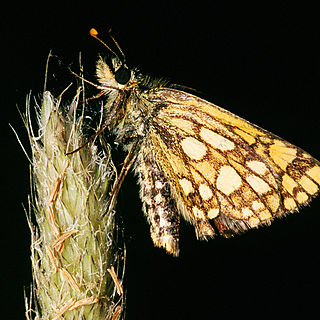
Scincella is a genus of lizards in the skink family, Scincidae, commonly referred to as ground skinks. The exact number of species in the genus is unclear, as taxonomic reclassification is ongoing, and sources vary widely. Scincella species primarily range throughout the temperate regions of the world and are typically small, fossorial lizards, which consume a wide variety of arthropods.

Carterocephalus is a Holarctic genus of skipperlings in the skipper family, Hesperiidae.
Tovomitopsis is a genus of flowering plant in the family Clusiaceae.
Symposia is a genus of South American araneomorph spiders in the family Cybaeidae, and was first described by Eugène Simon in 1898.

Weinmannia racemosa, commonly called kāmahi, is an evergreen small shrub to medium-sized tree of the family Cunoniaceae. It is the most abundant forest tree in New Zealand, occurring in lowland, montane, and subalpine forests and shrubland from the central North Island south to Stewart Island.
Craugastor silvicola, also known as the forest robber frog, is a species of frog in the family Craugastoridae. It is endemic to Mexico and only known from its type locality near Zanatepec, Oaxaca, on the Isthmus of Tehuantepec.
Berberis silvicola is a species of plant in the family Berberidaceae. It is endemic to China.
Drosera gibsonii is a species of pygmy sundew endemic to Stirling Range National Park in Western Australia. It is thought to be most closely related to Drosera silvicola.

Weinmannia silvicola, known as tōwai or tawhero, is a medium-sized evergreen tree of the family Cunoniaceae native to northern New Zealand. It grows to 15 m or more, with a trunk up to 1 m in diameter. Adult leaves are toothed and leathery, with up to five pairs of leaflets. Juvenile leaves are thinner and have up to ten pairs of leaflets. Flowers are small and pink or white, occurring in 8–12 cm racemes. Fruits are 4–5 cm capsules, which release many tiny seeds that are dispersed by wind. Tōwai occurs in forest and forest margins from North Cape south to the Waitākere Ranges west of Auckland. A closely related tree, Kāmahi , replaces tōwai south of latitude 37°S.

Intasuchus is an extinct genus of temnospondyl amphibian from the Late Permian of Russia. It is known from a single species, Intasuchus silvicola, which was named in 1956. Intasuchus belongs to the family Intasuchidae and is probably its sole member, although other taxa such as Syndyodosuchus and Cheliderpeton have been assigned to the family in the past. Intasuchus most likely belongs to the group Archegosauroidea, Permian relatives of the large, mostly Mesozoic temnospondyl clade Stereospondyli.

Carterocephalus silvicola, the northern chequered skipper, is a butterfly of the family Hesperiidae. It is found in northern Europe and north and east Asia.

Arctostaphylos silvicola is a species of manzanita known by the common names Bonny Doon or silverleaf manzanita. It is endemic to the sandhills of the southern Santa Cruz Mountains in California's Santa Cruz and Santa Clara counties.

Scincella silvicola is a species of skink that lives in the highlands of Mexico from Puebla to Oaxaca. It occurs primarily in dry, scrubby areas and forests, especially pine forests. It is generally a common species and faces no major threats. It is most likely ovoviviparous.

Sevenia, commonly called tree nymphs, is a genus of forest butterflies in the family Nymphalidae that, as larvae, feed on plants of the family Euphorbiaceae. There are fourteen species from continental Africa and two species from Madagascar. See Idea for the genus of Southeast Asian tree nymphs.
Precis rauana, the montane commodore, is a butterfly in the family Nymphalidae. It is found in Nigeria, from Cameroon to the Democratic Republic of the Congo and in Uganda, Kenya, Tanzania and Zambia. The habitat consists of forests.

Russula silvicola is a species of agaric fungus in the family Russulaceae. Found in North America, it was described as new to science in 1975. It is considered inedible. It has a strong peppery flavor.
Gymnoscelis silvicola is a moth in the family Geometridae. It was described by András Mátyás Vojnits in 1994. It is found in the Afrotropical realm.

The western round-eared bat is a bat species found only on the Pacific coast of northwestern Ecuador.

Cryphoeca silvicola is a small species of dwarf sheet spider in the family Cybaeidae which has a Palearctic distribution. The generic name, Cryphoeca, means hidden and the specific name silvicola means "living in the woods".

Thomas's big-eared brown bat is a species of vesper bat found in South America.














